Key Plant: Oleander (Nerium oleander)
Oleander (Nerium oleander) ranges from a rounded shrub to a tree standing 10 to 18 feet high with long dark green leaves. Oleander is known for its beautiful fragrant flowers, which vary in shades of red, yellow, white, or pink. It is a nonnative species, but it is adapted to climatic conditions throughout Florida and can be found in USDA Hardiness Zones 9A through 11. Oleander is mildly cold tolerant but may experience injury in very cold weather. Full sun is necessary for best flowering and for development of a full, fountain-shaped crown. In shade, it will grow lanky and produce few flowers. Oleander is tolerant of a wide range of soil types and grows well in sandy dry areas. While highly salt tolerant, it does not do well when directly exposed to salt spray. When planting in coastal areas, plant oleander behind the dune lines for best results. It is adaptable to a pH range of 5.0 to more than 8.3. Once established, it is very drought tolerant, but moist soils or irrigation stimulate growth. This species typically has low fertility requirements; established plants usually do not need fertilizer because root systems typically can extend into lawns, where they absorb nutrients from turf fertilizers (Gilman and Watson 2014).

Credit: John Ruter, University of Georgia, Bugwood.org
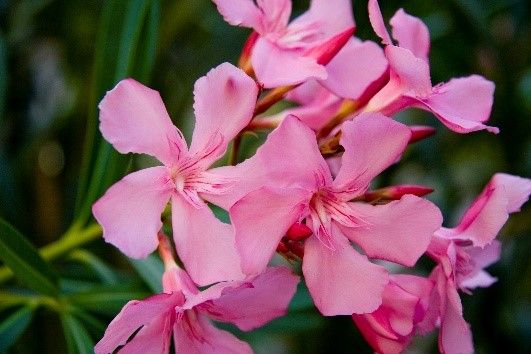
Credit: UF/IFAS
Key Pests: Oleander (Nerium oleander)
This series of Key Plant, Key Pests publications is designed for Florida gardeners, horticulturalists, and landscape professionals to help identify common pests associated with common Florida flora. This publication, the tenth in the Key Plant, Key Pests series, helps identify the most common pests found on oleander.
This publication provides information and general management recommendations for oleander aphids, oleander caterpillars, sphaeropsis gall, oleander leaf scorch, and scale. For a more comprehensive guide of woody ornamental insect management, download the current Professional Disease Management Guide for Ornamental Plants or the Integrated Pest Management in the Commercial Ornamental Nursery Guide.
Oleander Aphid (Aphis nerii)
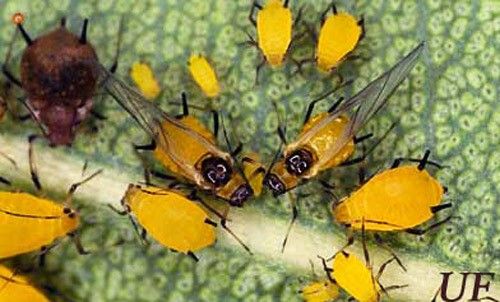
Credit: J. Castner, UF/IFAS
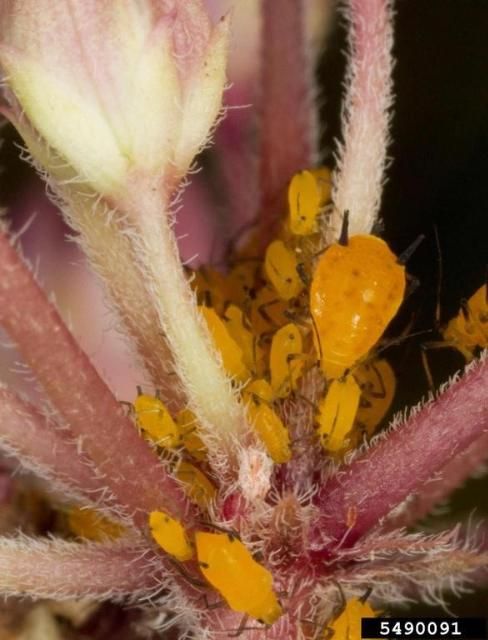
Credit: David Cappaert, Bugwood.org
Recognition
Oleander aphids are bright yellow with black markings and appendages. They cluster and feed on young tender growth. As with most aphids, sooty mold may be a sign of infestation due to the fungus growing on honeydew excretions.
Contributing Factors
This aphid is specific to oleander and milkweed. Aphids are usually most numerous in the spring but may be present throughout the growing season.
Management Recommendations
Aphid "mummies" are a sign that natural biological control is occurring. High aphid populations may be treated with insecticidal soaps, oils, or approved insecticides, but cultural controls offer the best means of managing infestations. Reduced levels of watering, fertilization, or pruning reduces the production of tender shoots, a favorite food of the oleander aphid. (McAuslane 2014).
Oleander Caterpillar (Syntomeida epilais Walker)
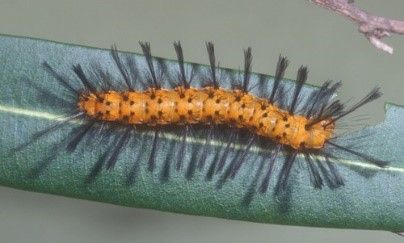
Credit: Paul Choate, UF/IFAS
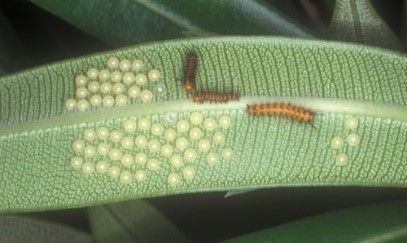
Credit: James Castner, UF/IFAS
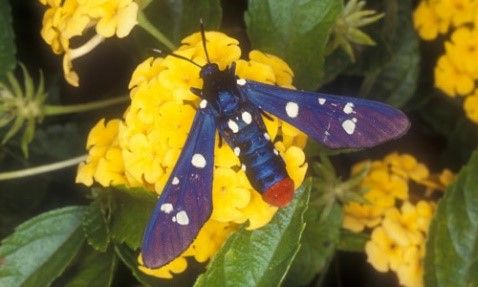
Credit: James Castner, UF/IFAS
Recognition
Early infestation of the oleander caterpillar is easy to recognize: feeding larvae turn new oleander shoots light brown, and eggs are found in clusters on the undersides of leaves. Oleander caterpillars have a distinct appearance at every stage of development. Caterpillars are a distinctive orange with tufts of black spiked hairs. The adult is a blue-black moth with white spots and a red-tipped abdomen, which looks like a wasp.
Contributing Factors
Oleander caterpillars thrive in warm weather. The caterpillar lives year-round in south Florida and the Keys, but it is usually killed by cold winter temperatures in north and north-central Florida. Yearly recolonization is common for this species.
Management Recommendations
Removal of larvae-infested branches is the most environmentally friendly control method. After removal, place in a sealable bag and freeze for 24 hours. Biological controls, such as the predatory stink bug, parasitic tachinid flies, and parasitic wasps are all natural predators of the caterpillar. Chemical controls should be considered the last resort for management. The use of Bacillus thuringiensis (Bt) when caterpillars are small, or other approved insecticides when larger, may be necessary (McAuslane 2016).
Sphaeropsis Gall (Sphaeropsis tumefaciens)
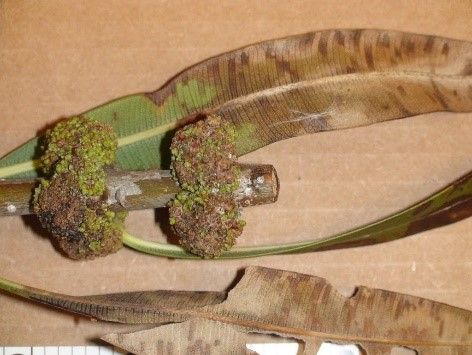
Oleander Leaf Scorch (Xylella fastidiosa)
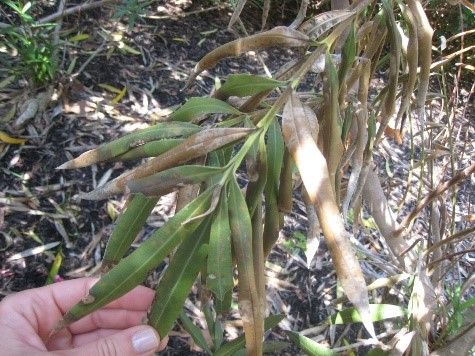
Credit: Laura Sanagorski, UF/IFAS
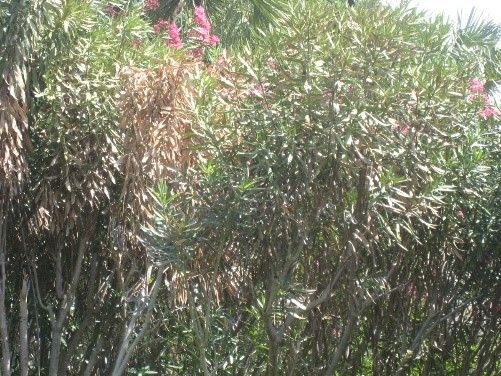
Credit: Laura Sanagorski, UF/IFAS
Recognition
Oleander leaf scorch is caused by a strain of Xylella fastidiosa. Leaves are affected with marginal scalloped chlorosis (yellowing), followed by marginal or tip leaf scorch, then dieback of twigs and branches. The disease seems to kill oleander within about two years of the first appearance of symptoms. Newly infected plants typically have one terminal branch that is infected first. As time goes by, more and more of the canopy will become infected and show symptoms until the plant eventually dies. Oleander leaf scorch symptoms are often confused with salt burn.
Contributing Factors
The bacterium lives in the xylem tissues of the plant and is spread from plant to plant by spittlebugs and sharpshooter leafhoppers that feed on the xylem. The spittlebugs can vector the bacterium from infected weeds to healthy plants. Because bacteria plug the xylem or water-conducting tissues of infected plants, symptoms are often confused with water stress or salt burn. Conditions where diseases are more easily transferred between plants, such as seasonal rainfall, amplify the opportunities for oleander to become infected. Care should be taken not to stress the plants for water.
Management Recommendations
As soon as infected shoots are detected, prune out all infected limbs in newly infected plants, 2 to 3 feet below symptoms. Sterilize tools between pruning of each plant. If a plant is completely infected, remove it. Pruning out infected branches with oleander leaf scorch symptoms showed a 50% reduction in observed disease the following year (Mizell et al. 2015; Sanagorski 2011).
Scale (Aspidiotus nerii)
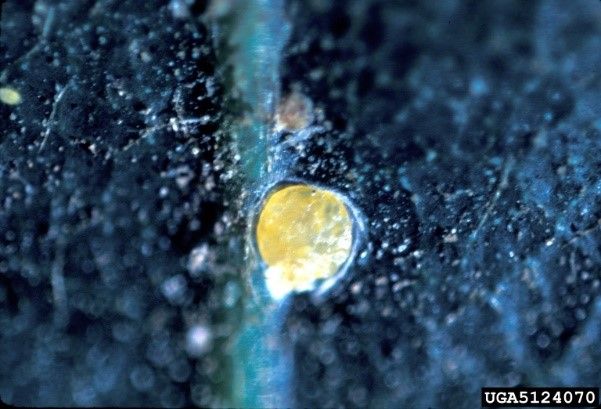
Credit: United States National Collection of Scale Insects Photographs, USDA Agricultural Research Service, Bugwood.org
Recognition
Oleander scale (Aspidiotus nerii) are small (1–2 mm) round whitish insects found on either the top or bottom surfaces of leaves. Their hard, armored shell makes them difficult to control. Typically, symptoms are related to the severity of the infestation, first appearing as wilting on leaves and stems, and eventually leading to leaf and shoot malformation, shriveling, and plant death.
Contributing Factors
Many scales are unable to move freely once they have settled, meaning long-range dispersal happens by transport or contact with infected plant material.
Management Recommendations
Biological controls for this pest include ladybird beetles, or ladybugs, and twin wasps. For mechanical control, scrape and scrub to remove scale from plants, and be sure to space plants apart properly to prevent spread. Insecticides may be used, but mode of action and formulation are important because scale's exterior armor protects all stages of life except crawlers (Tenbrink & Hara 1992).
Oleander Toxicity
According to the American Medical Association Handbook on Poisonous and Injurious Plants (1985), all parts of the oleander plant contain two toxic principles. These toxic principles, oleandroside and nerioside, have both been identified as glycosides. This extremely toxic plant can poison livestock and humans at any time of the year. Lethal doses of leaves for livestock have been established for horses (15–30 grams), cows (10–25 grams), and sheep (1–5 grams).
Despite its toxicity, many individuals in the landscape industry have spent years working with oleander without experiencing oleander poisoning from landscape workers or from plants in the landscape, although reports of fatalities due to ingestion of flowers exist.
Sources
Gabel, K. 2011. Oleander, gumbo limbos & buttonwoods are they galling you? Gainesville: University of Florida Institute of Food and Agricultural Sciences. http://blogs.ifas.ufl.edu/monroeco/2008/10/30/oleander-gumbo-limbos-buttonwoods-are-they-galling-you/
Gilman, E. F., and D. G. Watson. 2014. Nerium oleander: Oleander. ENH-571. Gainesville: University of Florida Institute of Food and Agricultural Sciences. https://edis.ifas.ufl.edu/st412
McAuslane, H. J. 2014. Oleander Aphid, Aphis nerii Boyer de Fonscolombe (Insecta: Hemiptera: Aphididae). EENY-247. Gainesville: University of Florida Institute of Food and Agricultural Sciences. https://edis.ifas.ufl.edu/in520
McAuslane, H. J. 2016. Oleander Caterpillar, Syntomeida epilais Walker (Insecta: Lepidoptera: Arctiidae). EENY-009. Gainesville: University of Florida Institute of Food and Agricultural Sciences. https://edis.ifas.ufl.edu/in135
Mizell, R. F., P. C. Andersen, C. Tipping, and B. V. Brodbeck. 2015. Xylella fastidiosa diseases and their leafhopper vectors. ENY-683. Gainesville: University of Florida Institute of Food and Agricultural Sciences. https://edis.ifas.ufl.edu/in174
Sanagorski, L. 2011. Oleander leaf scorch. Gainesville: University of Florida Institute of Food and Agricultural Sciences. https://palmbeachcountyextension.wordpress.com/2011/03/30/oleander-leaf-scorch/
Tenbrink, V., and A. H. Hara. 1992. Aspidiotus nerii (Bouche). Hilo: University of Hawaii. http://www.extento.hawaii.edu/kbase/crop/type/a_nerii.htm